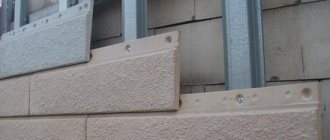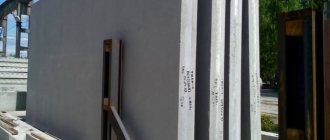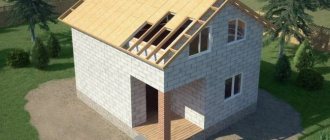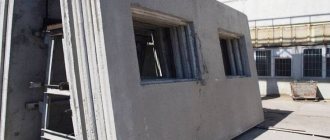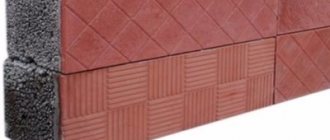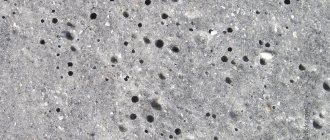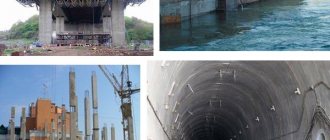Due to the popularity of loft-style interiors, materials such as wood, brick and concrete are becoming priorities in decoration. A historical loft is made up of brick walls of buildings in America and England from the early 20th century. They only had concrete floors, but a little later, in the second half of the 20th century, concrete began to be used in low-rise construction of industrial buildings. It was there that concrete appeared on the walls.
In Russia, not everyone can boast of beautiful brick walls from the times of Tsarist Russia with the seal of Nicholas 2 or picturesque concrete walls from the developer. It happens that the walls are concrete, but quite thin, and you want to make soundproofing so as not to hear your neighbors. And you want to make your interior unique and modern. In this case, an excellent solution would be to cover the walls with decorative concrete panels.
Decorative panels for concrete walls
The Hungarian company GIACOTTI presents on the market original decorative panels for walls that will highlight the design of the building.
Designer panels for walls in Moscow
Decorative panels for walls NATURAL
The appearance of the panels resembles raw concrete; the surface may contain small pores, stains, and changes in shade. The panels are completely smooth with a thickness of 15 to 20 mm depending on the size of the panels.
Decorative wall panels INDUSTRIAL
Porous surface, stains, scratches, cracks characterize this panel. A bestseller among our clients for both exterior and interior decoration.
Decorative wall panels WASH
The color of the filling material and the gravel in it can be freely chosen. Before the concrete is bonded, the top layer of cement is removed and the concrete admixtures are exposed. The design of the panel is limitless, you can wash various shapes and patterns.
Decorative wall panels STRUCTURED
Thanks to our special production technology, "Structured" panels offer a variety of surfaces with different types of imprint.
Decorative wall panels WITH ANKER DOTS
The peculiarity of panels with a circle Anchor is a special design element, the imprint of a circle anchor, which copies the print from the screws used when pouring monolithic concrete on construction sites.
Decorative wall panels STRUCTURED
Thanks to our special production technology, "Structured" panels offer a variety of surfaces with different types of imprint.
Decorative wall panels TERRA
When making Terra panels, mineral stones are added to the main ingredients of concrete. Thanks to these stones and parts, the panel resembles marble. This panel is highly customizable: the color and particle size can be freely selected, as can the color of the filler material, giving you an endless number of possibilities.
Decorative wall panels STAMPF
Stampf panels are characterized by a unique design, which is achieved thanks to a special dry manufacturing technology. We create different shades in one panel by manually inserting different layers.
Decorative wall panels SCALLOPED
A panel with a special appearance, made with any pattern in accordance with individual orders. Transmits light and weighs less than a solid panel. The Openwork panel looks good as a partition in interiors, and it is an effective decorative element on the facades of houses.
You can decorate a building from the inside or outside with decorative panels for walls. They will bring a special noteworthy appeal to the exterior or interior, place accents and, without words, “tell” about the impeccable taste and high status of the owner.
Decorative concrete, used in the manufacture of decorative panels, can replace natural stone or brick. They began to use it for interior decoration quite recently, but now concrete panels are in increasing demand.
Designers value decorative wall panels for their unique combination of refined grace of pattern and hard, brutal surface. This contrast creates a magnificent composition, embodied in perfection and harmony. It is recommended to order decorative wall panels for rooms decorated in special styles - loft, hi-tech, techno, minimalism. Vintage and art deco also fit perfectly with concrete fashion trends in building materials.
Panel designs
What designs are there?
Under the brick
Walls with brick decor created with sheet, tile or slatted panels imitate masonry. There are wooden MDF boards and plastic PVC. They are attached with glue to the wall or to the sheathing.
Under the stone
Stone-look walls look beautiful in the interior and do not take up much space. Lightweight panels made of plastic and gypsum imitate natural limestone, any masonry method and color.
Under the tree
Wood-look walls made of PVC or veneer are suitable for creating comfort and a classic interior. Additionally, they can be varnished for shine.
With relief
Embossed ones made of polyurethane or gypsum create a volume effect on the wall; they are suitable for finishing the central wall of a living room or the wall at the head of the bed.
With an image
Panels with a pattern are additionally protected by an acrylic layer. Highly durable and stable panels are suitable for decorating a nursery with a fairy tale theme, a bathroom with a marine interior, or a kitchen.
The photo shows a teenager's bedroom with wall coverings and a photo print that emphasizes the child's individuality and preferences.
Concrete finishing - trends in modern interiors
The purpose of architectural concrete is related to the finishing of both external facades and interiors. In addition to important properties such as strength and high resistance, it also has aesthetic advantages. His contemporary mission is to change the current perception of rendered concrete.
Characteristics of decorative panels for concrete
One of the characteristic features of architectural concrete is its production for a variety of projects, including individual ones. For this reason, there are many varieties of decorative panels available in the market. Their appearance depends not only on the components of the concrete mixture, but also on the production process, transportation, installation method or maintenance. Architectural concrete, as a rule, does not require any additional finishing. Despite its harsh appearance, architectural concrete in interior decoration has a large number of fans.
Moreover, among fans of this type of finishing there are many who prefer it in the form of plates.
Manufacturers allow you to produce architectural concrete yourself. They offer different types of mixtures that are mixed with water and poured into appropriate molds.
Modern decorative panels can be made of architectural concrete of various thicknesses and using mixtures of various compositions. Before purchasing, you need to pay attention to the properties of the slabs or mixtures and the requirements for the operating conditions of the future coating, including the need for impregnation. Appropriate impregnation affects the properties of the material. Pay special attention to humidity requirements and the ability to withstand low temperatures, as well as resistance to mechanical damage.
Colors and textures of decorative concrete panels
The appearance of concrete slabs is greatly influenced by their color and texture. There are concrete slabs on the market in shades of white, ivory or typically gray. These slabs are especially loved by supporters of the modern loft style, not only in light, but also in darker shades of gray and even black, emphasizing the character of concrete.
The same can be said in the case of textures. You can find solutions based on porous slabs (such as travertine or slate patterns) as well as smooth surfaces that highlight the minimalist character of modern interiors.
Of course, smooth plates are an excellent choice for those looking for a uniform finish. However, the porous structure is much more comfortable.
Concrete and company: what is the best material to combine with
Concrete will take its rightful place in the design of rooms, but it is better to complement it with other textured and colorful materials. We talk about the most successful combinations and show photo examples of unique designs in industrial styles.
Tree
To make a concrete interior feel warmer and more homely, you can add decorative wooden elements. Another option is to use slats and beams to cover the walls and ceiling. Furniture can also play a role in creating a unique ensemble.
Concrete and wood in the interior of an apartment are a common combination for grunge and loft styles. For a successful balance, it is worth giving preference to one of the materials, and using the second to correctly place accents.
Combination of concrete and wood in design
Combination of concrete and wood in the interior of the apartment
Brick
Concrete and brick in the interior are another successful technique for the loft style. The trend of the direction suggests the presence of one brick wall in the room. The remaining surfaces can be treated with decorative concrete or simply remove the wallpaper. If you're not ready to take a radical step, go for an unusual floor design. The gray polished surface looks brutal and fashionable.
A white concrete wall is appropriate in a loft design. It will highlight the color of the brick and create a unique atmosphere of brutality. Metal lamps, intricate racks and shelves will not be out of place.
Combination of concrete and brick in the interior of the apartment
Combination of concrete and brick in design
Steel
The concrete finish blends perfectly with the steel elements. You can make walls or floors from the base material and add metal studs, ladders or ceiling bars to the design.
The cold restraint of concrete and steel shine will turn any room into a masterpiece of style. If you want color accents, you can add bright details in the form of indoor plants, posters, rugs.
Combination of concrete and steel in design
Concrete and steel design in an apartment
Manufacturing of panels
To make such finishing elements you need to spend a lot of time, about 4 weeks. Everything is due to the fact that concrete matures for exactly this amount of time. Let's consider the main stages of manufacturing concrete panels.
- Creation of high-quality concrete solution. To do this, all dry ingredients are mixed with water. It turns out to be a rather liquid mass. The last component will be the dye. Manufacturers use only natural dyes. They are based on zinc oxide. It is this component that allows the panels to retain their original color for a long time. After adding the dye, the solution is stirred until the mass acquires a uniform shade.
- When the solution is ready, it is poured into the required forms. Then fiberglass is placed into the molds. In order for the elements to have high strength fiber, they are laid in at least 5 layers.
- Then the forms with the solution stand for 28 days. In this case, it is necessary to maintain a stable temperature and appropriate ambient humidity. If everything is done correctly, the product will be of the highest quality.
- The last step will be processing the outer surface. For this purpose, fixing and moisture-repellent compounds are used.
Types of concrete panels
Concrete panels may vary in color and surface finish. We will conditionally divide the panels into 3 types:
- Let's start with the simplest ones. These are lightweight, durable panels from graphite-gray to white with clearly visible large pores, with a diameter of 3 to 15 mm, but with a smooth matte or glossy surface. The thickness of these panels depends on the size and starts from 8 mm. They can be either with or without imitation fastening recesses.
- Next come panels with a small number of pores, a diameter of less than 3 mm, or no pores at all, having a glossy or matte, slightly textured surface of any color.
- And the last ones are exclusive panels: with three-dimensional patterns, paintings, inscriptions, or in general panels inlaid with metal strips, shells, minerals and everything your heart desires.
How much does decorative concrete finishing cost in Moscow?
The cost of finishing the facade or decorating walls and ceilings with stucco molding from decorative concrete consists of the following factors:
- Scope of work. In our company you can order the production of decorative elements, sculptures and MAFs in any quantities. When placing an order, you need to remember that a batch of identical garden figurines will cost less than producing the same number of products if each of them has an individual design.
- Complexity of the project. Our specialists will create stamps, molds and matrices for casting decorative concrete products in any of the well-known styles - classic, modern, loft, hi-tech, avant-garde. If the customer finds it difficult to choose the design and color palette of the MAF, architectural or interior decor, we are ready to offer the production of decorative elements according to our designer’s original design.
- Manufacturing technology. Our production base is equipped with modern equipment, thanks to which we always comply with agreements and carry out work of any volume and complexity on time and without delay.
- Additional services. We offer our clients a full range of services, including the production of molds and casting of decor, delivery of products throughout Moscow and the Moscow region, professional installation of finishing, installation of sculptures and small architectural forms.
What are wall panels?
The use of modern finishing materials allows you to finish the room quickly, efficiently and without unnecessary dirt. Wall panels are a functional and aesthetic option for creating a modern interior. Manufacturers offer a wide range of cladding, varying in shape, size and decorative features.
Product performance and cost vary depending on the material. Panels can be made of wood and its processing residues, plastic, glass, gypsum . Artificial slabs are offered with imitation stone, metal, leather, brick. The products are mounted on lathing or special glue.
Varieties
Decorative panels for walls are classified into 3 groups according to their shape:
- Rack and pinion Externally, the installed coating resembles lining. Set products are produced up to 6 m long, but more often you can find 2.2-3 m. The width of each plank is 10-30 cm, thickness - 8-25 mm. The parts are fixed using a tongue-and-groove system. The locking connection allows you to create a single, durable structure. The panels are made of plastic or wood. This type is recommended for small rooms; vertically positioned planks visually increase the space. Horizontal installation reduces the height of the ceilings, but visually lengthens the room. During installation, a starting and finishing strip and additional elements for external corners are used.
Scope of application
Decorative panels are used in the interior of cottages, dachas, and apartments. With their help, the ceiling and walls are decorated, rooms are zoned, columns and partitions are created. Glass slabs are popular as a kitchen backsplash; plastic is used to make a bathroom screen . Cladding is used in office premises, cafes and restaurants, hotels, and public buildings.
Types of products for facades
Concrete panels are available in various colors and textures. However, they generally give preference to natural shades; they provide better protection from ultraviolet radiation. In addition, concrete products with bright, saturated colors have a higher price. You can also choose slabs that are ready for painting.
Classification of concrete panels by appearance:
- concrete panels for brick – on one sheet there are several elements that repeat the size of the masonry.
- Wood-effect panels – decorative boards resemble boards or aged wood.
- Volumetric slabs (3D products) – allow you to create a complex three-dimensional design.
- Slabs with imitation of natural stone - granite chips are added to the composition of the products. Can be square or rectangular.
- For stone cutting - they are distinguished by a wide variety of colors; they have a ceramic coating on the outside for additional strength of the protruding parts. In terms of price category, they are the most expensive.
- With imitation plaster. Slabs with a smooth surface.
So, concrete panels can imitate almost any building material, and their price is more favorable. If this is not an imitation, then it is simply a very beautiful texture: ribbed, grainy, with a geometric pattern. It happens that looking at the façade cladding, you may not even think about concrete slabs. And they are used quite actively. Concrete facade panels made to look like brick, stone, wood, plaster have gained popularity, and the 3D format is especially stylish these days.
Current design ideas
Plastic panels or products made from other materials are successfully used for arranging various rooms.
MDF panels. The models are created from wood waste using the hot pressing method; the material contains no toxic impurities. Safe products are even used for cladding a children's room; the appearance of the material is improved by a decorative film decorated with an unusual pattern or imitating various textures.
If the panels are laminated, they can be easily wiped with a damp sponge; installation is carried out using platbands and corners.
Based on wood fiber boards. Cheap fiberboard panels made by hot pressing are superior to MDF models in thickness, and are slightly inferior to them in performance characteristics.
Based on particle boards. The products are made from shavings with sawdust, but the composition contains binders that cannot be called environmentally friendly. Chipboard is afraid of moisture; the model is best used for cladding non-residential premises: hallways and corridors.
Wooden. Aesthetic panels bring nobility and prestige to the interior; the cladding material is expensive wood veneer; an additional effect is created by mirror inserts, natural shades, carved elements and gilding.
Cork. Manufacturers produce these panels mainly in two layers. Pressed cork chips are at the bottom; pieces of cork oak bark are added to the top layer. The panels improve sound and heat insulation, they are durable and are not susceptible to mold.
Plastic. PVC panels can be used in any room: they are environmentally friendly, fireproof, and moisture resistant. Easy installation of wall panels is an important advantage; every craftsman can do the cladding with his own hands.
Bamboo panels are exotic products; they are used to decorate interiors in African, country or ethnic styles.
3D panels. The products have a three-layer structure; on top there is a decorative and reinforcing layer, which gives high strength to the structure.
Glass. This is a popular new product on the market of facing materials; its popularity is explained by its excellent resistance to moisture or other external influences.
Advantages and features
The advantages of soft wall panels include:
- Excellent sound insulation and noise reduction properties. The panels are made of materials that do not transmit sound and heat well (the base and especially the foam filling). This allows several times to reduce heat loss through the walls of private houses or city apartments. In panel high-rise buildings, such panels will be appreciated by those who have to live next to noisy neighbors.
- Noise dissipation. Within one apartment, noise spreads quite easily even to distant rooms. They are reflected from the ceiling and walls and spread unhindered. But soft panels absorb or dissipate noise. It practically does not extend beyond the room and the entire apartment or house becomes much quieter.
- Masking wall defects and saving on plastering walls and ceilings. The panel perfectly hides all unevenness and can be installed directly on a concrete wall or brickwork. However, if the panel does not cover the entire wall, you will still have to plaster it.
- Extremely simple and quick installation. You can even install solid panels yourself. Installing prefabricated panels or those combined with brass inserts is more difficult, so it is better to entrust this work to professionals.
- Easy care. It is enough to periodically wipe leather and leatherette panels with a damp cloth or napkin. You can use a vacuum cleaner to clean fabric panels.
- Safety. None of the panel elements contain harmful substances and cannot harm life and health. Decorating children's rooms with soft panels reduces to zero the risk of a child being injured on the wall.
- Ability to maintain shape for a long time. The panels are not afraid of compression. Their filling is the same as in many pieces of upholstered furniture (chairs, sofas, etc.), so you can lean on the panels or lean on them without fear.
- UV resistance. Materials that are resistant to sunlight are selected as a decorative layer.
Finishing with MDF panels
Now, having such a variety of MDF products, you should not limit yourself to decorating only the corridor, balcony or loggia, although they can be decorated in a completely new way by choosing the appropriate design option. You can successfully decorate the walls of the living room, hallway, kitchen, as well as ceilings, entrance doors, and the sides of staircases with such sheets.
You can successfully decorate the living room walls with such sheets.
Hallway
Decorating a hallway is not as easy as it first seems. This is a problematic room because there is little light in it. It usually contains several doors, which create difficulties when installing panels. Here the walls are most exposed to contamination because the hallway is a common area and is not as large as the living room.
In the hallway the walls are more dirty
Taking these features into account, it is better to decorate the hallway with slatted panels. They are convenient for cladding a hallway, because they are small in size and can fit into any problem area.
The appearance of the surface of such products should correspond to the style of the hallway and its characteristics. For cladding a small hallway, light, monochromatic products are better suited; they will visually enlarge the room.
Slatted panels for a small hallway
It is successful to use vertically arranged panels of yellow and white colors, which alternate with each other. The doors are upholstered with brown slats to match the furniture elements located in the corridor.
Vertical MDF panels in two colors in the hallway
The walls in the hallway cannot be completely finished with panels. The corridor looks interesting, in which the walls are covered with MDF only on the bottom, and on top are covered with wallpaper that matches the tone.
This design can be used for a medium-sized hallway or in a large space.
Living room
All walls in the living room are rarely lined with MDF panel elements. An interior in which this material is used only in fragments will be attractive.
Wall cladding with light panels
For example, you can focus on one wall by covering it with 3D panels with a pattern that suits the style. The photo shows a design option for a living room, in which one wall is lined with 3D elements in the form of waves. This panel fits well into the overall interior of the living room.
3D waves in your living room
Designers often use panels to cover one wall to complement some piece of furniture, for example, finishing a wall on which a TV hangs.
The accent for the wall is a picture or TV
If you nevertheless decide to cover the walls in the living room completely with panels, carefully consider their location. The longitudinal arrangement is suitable for rooms with low ceilings. This visually increases the height of the room.
Longitudinal arrangement of panels for low ceilings
The transverse arrangement is suitable for large spaces.
The transverse arrangement of the panels is suitable for a large room
Bedroom
The walls of the bedroom, like those in the living room, are rarely lined with MDF. If you plan to use this material for wall cladding in this room, you should approach it with caution. Despite the safety of its modern manufacture, it is wiser to use soft, breathable wallpaper for a bedroom in an apartment. But for a private house or cottage, where the room is not heated in winter, it is quite suitable.
The best solution for MDF panels for a private home
MDF is not afraid of large temperature fluctuations and is not subject to deformation due to this. It is also better to cover the walls in the living room in fragments. The wall at the head of the bed is often decorated with this material.
Finishing material at the head of the bed
The cladding of the wall behind the berth with 3D panels with an imitation of carriage reupholstery looks interesting. This design looks especially modern.
Bathroom and toilet
Modern MDF wall panels can be successfully used for finishing bathrooms and toilets. Nowadays many types of such products with moisture-resistant qualities are produced.
A beautiful and unusual solution for the bathroom
With their help, you can successfully imitate ceramic tiles without fear of destruction of the material from moisture. At the same time, it will cost much less than tiles. At the same time, the variety of design designs is much wider than ceramics. You can use panels with fragments of a painting applied to them to create a whole panel in the bathroom.
Panel made of MDF panels in the bathroom
By choosing the products in the form necessary to implement your intended style, you can decorate your bathroom in a completely original way.
Moisture-resistant panels for bathroom decoration
The bathroom is finished with panels coated with protective varnish in dark colors. With a white bathtub and sink, the walls look magical.
Dark room with white fixtures
By using a design in light colors, you can get a completely different look for your bathroom.
Light bathroom with black accents
Such walls will last quite a long time. They also wash well from dirt without losing color brightness. The only negative is that you cannot use aggressive cleaning agents to avoid scratching the protective surface.
Eco-friendly material for comfort
The protective and decorative layer of MDF must be protected from damage so as not to reduce the material’s resistance to moisture.
Loggias
For covering the walls of balconies and loggias, MDF products are the most popular. Given the varied designs of modern panels, these places can be turned into a wonderful relaxation space by completely finishing all the walls with such materials.
The most popular material for finishing balconies
They are easy to install, wipe clean from dust and are not afraid of discoloration from sunlight.
Looks calm and natural
Materials and design
Imitating factory brick walls is one of the traditional design techniques. But loft is not only rough masonry; other textures can be harmoniously incorporated into it. Materials such as:
- concrete;
- brick - untreated or painted (white, black, shades of gray);
- stone;
- plaster;
- metal - steel, copper, brass;
- textured wood - most often pine;
- leather.
The modern market offers all these materials in the form of wall panels. Such finishing can be represented by the following products:
- natural products (wood, plaster, metal);
- composite - a layer of natural material is applied to a base made of MDF or polymers (sprayed micro-concrete, cut stone);
- Fibreboard, chipboard, MDF with lamination and imitation textures;
- panels based on gypsum particle board with HPL lamination;
- PVC panels with printing or relief.
Cladding made from natural materials looks authentic and expensive - for example, a chic panel made from barn boards. Panels made of hot-rolled steel sheets or perforated metal will make the interior stylish and memorable. An original solution for interior decoration is concrete panels (sometimes gypsum with pigments acts as concrete). Russian and European manufacturers have launched the production of panels made of lightweight decorative concrete reinforced with fiberglass . You can choose different formats, dimensions, shade, level of relief (from smooth to very porous and even with a 3D pattern). This concrete can visually and tactilely imitate stone and wood. It is not afraid of changes in temperature and moisture.
The panels can be attached in a closed or open manner using end caps, enhancing the industrial character. Such fastening with bolts and rivets around the perimeter of the sheet is a striking decorative element and looks great on metal panels. PVC panels realistically reproduce any design: masonry of all colors, textured wood, cement, leather. They are easy to cut and simple to install. PVC can be washed and used in the kitchen and bathroom.
The assortment includes affordable domestic and more expensive panels from Belarus, Belgium, and Spain.
Panel release form:
- leafy;
- rack and pinion;
- cell phones;
- tiled;
- with 3D effect.
The sheet material has impressive dimensions: a height of 2.2 m and a width of 1.25 m. It is most often attached to a flat wall with glue, without lathing. Rack and pinion options usually have a tongue-and-groove connection. The length of the slats ranges from 2.4 to 3.6 m, width - from 12.5 to 30 cm.
A variety of decorative wall panels with photos
The panels vary in shape, have characteristic properties, are used in a particular room, and perform certain functions. The forms are divided into three groups.
- Slatted panels are long planks, for the production of which PVC, fiberboard, chipboard, and MDF are used. They are often mounted in rooms with many corners, in small rooms. Light panels can visually adjust the space of a small room. The horizontal arrangement of the planks will elongate the walls, and the vertical arrangement will visually raise the ceiling of the room. Wall panels of this shape are easy to install; they are attached with staples or screws to aluminum or wooden sheathing.
- Tile panels are square in shape from 30 cm to 1 m. They are fastened with steel plates or glue. If you arrange wall panels on a plane in different ways, you will get interesting options for wall decoration. An impressive touch will be the lighting built between the panels.
- Sheet wall panels are the largest in size (1.22 by 2.44 m, thickness - 3 cm), most often made of PVC and fiberboard. They form a multi-level structure with an applied pattern, texture that imitates other finishing materials (wood, stone, brick) or a combination thereof. The panels are attached with glue, and the seams formed between them are filled with moldings.
Room design with wall panel
Wall panels in the interior
| Kinds | Material | Advantages | Flaws |
| Wooden panels | Oak, cedar, maple, alder, walnut, pine | Eco-friendly material; Improves the interior; Combines with other facing materials | They do not tolerate moisture; High price |
| MDF - panels | Wood waste compressed under high temperature | They have sound and heat insulating properties; Can be made moisture-resistant, fire-resistant; Easy to care for | Not recommended for use in the kitchen or bathroom |
| Fiberboard - panels | Wood fibers compressed at a temperature of 180-200 C | Wide range of colors and textures | Low moisture resistance |
| Chipboard - panels | Sawdust and shavings impregnated with formaldehyde resins | Big choice panels covered with veneer, plastic | Harmful to humans and the environment; Cannot tolerate high humidity; Difficulties during installation |
| Bamboo panels | Bamboo tess | Easy to install; Withstands changes in humidity; Vapor permeable; Universal; Acceptable price | Cannot withstand severe mechanical damage |
| Gypsum vinyl panels | Vinyl coated drywall | Strong, durable; Combines with other finishing materials | Insufficiently moisture resistant; Not all products are suitable for cleaning |
| Glass panels | Strained glass | Resistant to external natural influences and moisture; Serve as a solid basis for creating drawings | Do not clean with products containing abrasives; Difficulty in cleaning the surface in the form of streaks and stains; Exposure to direct sunlight will damage the pattern on the panels over time |
| Stone veneer | cut stone | Environmentally friendly and safe material; Durable and reliable; Adapts to any surface shape | High price |
| Soft panels | Leather, textiles | Easy to care for; Resistance to moisture, sunlight and temperature changes; Soundproofing | Frequent cleaning required; For any damage, the entire panel is replaced |
The following types of panels deserve special attention. Some of them appeared relatively recently and differ from previous ones in their originality and creativity.
Modern room design with wall panel
Apartment interior with wall panel
Self-adhesive
Self-adhesive wall panels are popular due to their versatility and positive characteristics. In addition to the advantages described above, this type of product is not susceptible to mold or rotting. It comfortably tolerates temperature changes, which allows the panels to be used in the bathroom.
A distinctive feature is simple installation. No special tools or knowledge required. It is enough to remove the protective film and apply the panel with the desired side to the surface, give it time to stick. Therefore, cladding is quick and easy. Self-adhesive elements can be of different shapes, including rectangular and square.
A distinctive feature is simple installation.
Heat-resistant (fireproof)
An excellent solution for the area next to the stove. The fire-resistant type is divided into several types. The difference between them lies in the reaction to the flame, the increase in temperature indicators, the composition and processing of the material. The ease of combustion and the toxicity of substances released during combustion depend on this.
The best are panels made of completely non-flammable materials that will not catch fire from a spark or a full-fledged flame.
There are products that are difficult to burn. The peculiarity is that they themselves do not ignite, but when exposed to fire, a fire will start. Products of medium thickness are suitable for walls.
The best are panels made of completely non-flammable materials that will not catch fire from a spark or a full-fledged flame.
Colored
They are PVC plates that are made using colored material. Painting occurs with special dyes that penetrate completely into the depth of the product. Color options expand the possibilities of using the panels.
Color options expand the possibilities of using the panels.
Other possible options
There are options using office printing and flexography. Special machines are used that take part in the decoration of wall panels. The machine rolls over the surface, leaving a pattern. There is also a type of products with thermal printing. The decor is applied using high temperatures and special paint. These methods make it possible to obtain original products, perhaps even with an individual design.
The decor is applied using high temperatures and special paint.
Differences between architectural concrete and ordinary concrete
Both varieties have the same basic composition - crushed gravel, sand, water and plasticizers. However, to obtain architectural or art concrete, pigments for coloring, colored glass to create texture, or ceramic chips are introduced into the mortar. It also contains special levelers that make the color of the coating uniform. If complex structures are created from the material, more plasticizers are added to the solution.
The decorative coating in the interior looks expressive, harmonizes with the overall decor and gives the room a finished look.
The decorative concrete coating in the interior looks expressive and harmonizes with the overall environment
